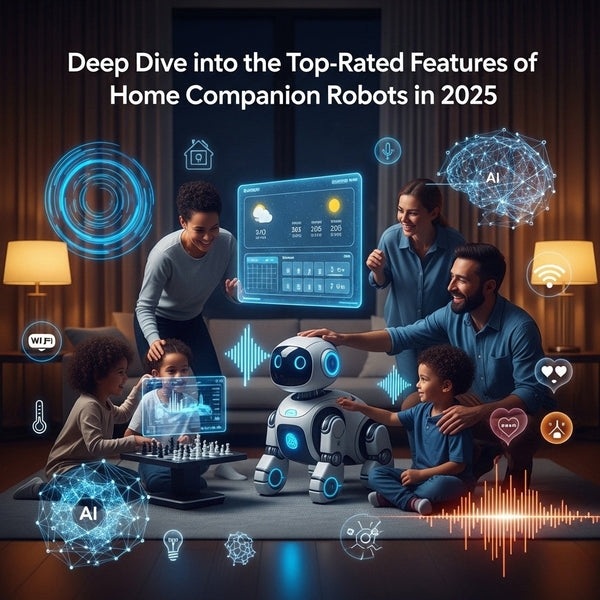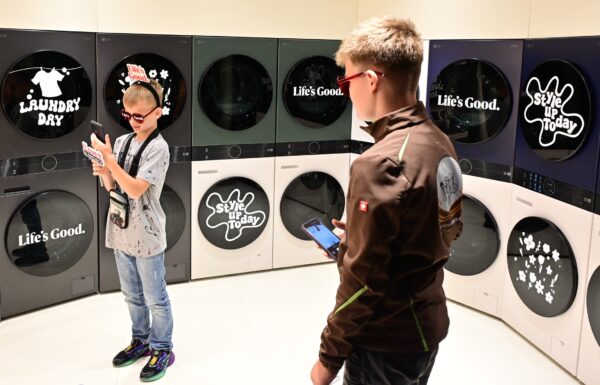For decades, the concept of a personal robot companion has been a staple of science fiction, a futuristic dream of a helpful, intelligent machine seamlessly integrated into our daily lives. While the reality has been slower to arrive than predicted, recent breakthroughs in artificial intelligence, sensor fusion, and edge computing are finally closing the gap. We are witnessing a pivotal shift in consumer robotics, moving beyond single-task automatons like vacuums and lawnmowers towards a new era of multifaceted AI companions. These devices are not just tools; they are being designed as proactive, context-aware members of the smart home ecosystem. This article delves into the technological advancements driving this revolution, explores the practical applications reshaping our homes, and examines the critical considerations for a future where personal AI robots are commonplace.
From Single-Task Automations to Integrated Companions
The journey toward the modern AI personal robot has been an evolutionary one, marked by incremental but significant steps. Understanding this progression is key to appreciating the complexity and potential of the latest generation of devices that are making headlines in Robotics News and Smart Home AI News.
The Journey from Roombas to Rosie the Robot
The first wave of consumer robotics was defined by function-specific devices. The most prominent example, covered extensively in Robotics Vacuum News, was the autonomous vacuum cleaner. These early robots were marvels of basic navigation and automation, capable of performing a single chore with minimal human intervention. However, their intelligence was limited. They reacted to their environment rather than understanding it. The next major leap came not in physical form but in digital intelligence. The rise of voice-activated smart speakers and displays brought conversational AI into the mainstream. This trend, a constant feature in AI Assistants News, gave us a disembodied “brain” for the smart home, capable of answering questions, controlling lights, and playing music. The critical missing piece was embodiment—the ability for that intelligence to move, perceive, and interact with the physical world. The current wave of AI Personal Robots News is all about merging these two worlds: combining the advanced conversational and predictive intelligence of AI assistants with the physical mobility and sensory awareness of a sophisticated robotic platform.
Key Players and Emerging Concepts
Today’s emerging personal robots are far more than just speakers on wheels. They are conceived as mobile command centers for the home. Many concepts highlighted in AI Research / Prototypes News showcase small, agile robots designed to be unobtrusive companions. These devices act as a physical interface for the entire smart home, capable of projecting screens, managing other smart devices, and providing a sense of presence. Their form factors vary widely, from rolling spheres to more complex designs with articulated limbs. The core concept is to create an AI Companion Device that can anticipate user needs based on learned patterns and real-time sensory input, a significant leap from the reactive nature of their predecessors. This includes not just home management but also security, entertainment, and personal assistance, blurring the lines between numerous gadget categories.
The Technological Symphony: AI, Sensors, and Connectivity
The sophisticated capabilities of modern AI robots are not the result of a single breakthrough but a convergence of multiple advanced technologies working in concert. This technological symphony is what allows a robot to perceive, understand, and act within the complex and dynamic environment of a human home.

The ‘Brain’: AI and Edge Computing
At the heart of every personal robot is a powerful processing unit running complex AI models. A crucial trend covered in AI Edge Devices News is the shift from cloud-based processing to on-device, or “edge,” computing. By performing calculations locally, these robots can react faster, function without a constant internet connection, and, most importantly, enhance user privacy by keeping sensitive data like camera feeds within the home. This on-device brain processes data from various inputs. Natural Language Processing (NLP) allows for nuanced voice commands, while advanced computer vision models, a topic central to AI-enabled Cameras & Vision News, enable the robot to recognize people, pets, and objects. The advancements in specialized processors seen in AI Phone & Mobile Devices News, such as Neural Processing Units (NPUs), are being adapted for these robotic applications, providing the power needed for real-time AI without excessive heat or energy consumption.
The ‘Senses’: A Fusion of Advanced Sensors
To understand its surroundings, an AI robot relies on a sophisticated suite of sensors, a key topic in AI Sensors & IoT News. Unlike a stationary smart speaker, a mobile robot must constantly map and navigate its environment. This is often achieved using LiDAR (Light Detection and Ranging), the same technology making waves in Autonomous Vehicles News, to create a precise 3D map of the home. This is augmented by 3D depth cameras for close-range object avoidance and spatial awareness. An array of microphones allows for sound source localization, enabling the robot to know who is speaking and from where. This rich sensory data is the foundation for its intelligence, allowing it to perform tasks ranging from home security patrols, a major aspect of AI Security Gadgets News, to simply finding its owner in a crowded room.
The ‘Nervous System’: Smart Home Integration (IoT)
A personal AI robot’s true power is unlocked when it acts as the mobile conductor of the smart home orchestra. It is not just another device on the network; it is the central hub that connects and commands everything else. Through IoT protocols like Matter and Thread, the robot can communicate with a vast array of devices. For instance, upon detecting you’ve sat down to watch a movie, it can autonomously dim the smart lights (AI Lighting Gadgets News), close the smart blinds, and send a command to your smart television. It can monitor Smart Appliances News staples like refrigerators or ovens, providing mobile alerts. This level of proactive integration transforms the smart home from a collection of remote-controlled gadgets into a truly intelligent and responsive environment.
Practical Magic: How AI Robots Will Reshape Daily Routines
The abstract technology translates into tangible benefits that can redefine our daily lives. By creating a “day in the life” scenario, we can see how these robots move from novel gadgets to indispensable assistants.
The Proactive Morning and Wellness Partner
Imagine waking up not to a blaring alarm, but to your personal robot gently opening the blinds and projecting the day’s weather and calendar onto the wall. Having integrated with your AI Sleep / Wellness Gadgets News tracker, it knows you had a restless night and suggests a light morning yoga routine, which it projects for you to follow. As you head to the kitchen, it has already signaled your smart coffee machine to start brewing, a perfect example of AI Kitchen Gadgets News in action. This scenario highlights a shift from manual commands to automated, context-aware assistance that streamlines morning routines and promotes well-being.

The Guardian and Family Entertainer
While you are away, the robot enters guardian mode. It can perform security patrols, using its cameras and sensors for AI Monitoring Devices News, and alert you to any unusual activity. For pet owners, it’s a game-changer, capable of dispensing treats, initiating laser-pointer play sessions, and providing a mobile video link for you to check in—a major evolution in AI Pet Tech News. For families, the robot becomes an interactive hub for learning and fun. It can project educational content for children, transforming any surface into a classroom, a concept driving AI Education Gadgets News. In the evening, it can become the center of family entertainment, projecting a movie onto a blank wall or facilitating interactive games, merging the worlds of AI Toys & Entertainment Gadgets News and home cinema.
Accessibility and Independent Living
Perhaps the most profound impact of personal AI robots will be in accessibility. For the elderly or individuals with mobility challenges, these devices offer a new level of independence. The robot can act as a mobile communication device, connecting them with family via video call without requiring them to handle a phone or tablet. It can provide medication reminders, fetch small items like a remote control or a bottle of water, and monitor for falls or signs of distress. This application, at the intersection of Health & BioAI Gadgets News and AI for Accessibility Devices News, showcases how technology can provide not just convenience but also critical support, safety, and peace of mind for both users and their caregivers.
Navigating the Future: Hurdles and Horizons
The path to widespread adoption of personal AI robots is promising but not without significant challenges. Addressing these issues head-on will be crucial for building consumer trust and realizing the full potential of this technology.

Technical and Ethical Hurdles
The most significant concern is privacy. A mobile device with always-on cameras and microphones inside our most private spaces requires a robust security and privacy framework. The emphasis on AI Edge Devices News is a direct response to this, as on-device processing minimizes the data sent to the cloud. Manufacturers must be transparent about data handling policies and build in strong encryption and user controls. The cost of the complex hardware and software will initially be high, placing these devices in a premium category. Furthermore, designers must navigate the “uncanny valley,” ensuring the robot’s appearance and interactions are helpful and endearing rather than unsettling. Reliability is also key; a robot that constantly gets stuck or misunderstands commands will quickly become a source of frustration rather than help.
Future Opportunities and Integration
Looking ahead, the opportunities are vast. We can expect deeper integration with other emerging technologies. Imagine a robot projecting interactive information overlays that you can manipulate through AR/VR AI Gadgets News headsets. In the more distant future, advancements in Neural Interfaces News could allow for even more seamless control. We will also see specialization. There may be robots designed specifically for the kitchen, assisting with recipes and cooking processes, or for fitness, acting as a dynamic personal trainer as seen in AI in Sports Gadgets News. The data generated by these devices could even contribute to broader initiatives like Smart City / Infrastructure AI Gadgets News, helping to optimize energy consumption on a neighborhood scale (a focus of AI for Energy / Utilities Gadgets News), all while respecting individual privacy.
Conclusion
We are standing at the threshold of a new chapter in human-computer interaction. The latest developments in AI Personal Robots News signal a definitive move away from niche, single-purpose gadgets toward truly integrated, intelligent home companions. The convergence of powerful on-device AI, sophisticated sensor arrays, and seamless IoT connectivity is the engine driving this transformation. While significant challenges related to privacy, cost, and social acceptance remain, the potential benefits are immense. From enhancing our daily convenience and entertainment to providing critical support for independent living, these AI companions are poised to fundamentally reshape our homes and our relationship with technology. The science-fiction dream is becoming a practical reality, and the next few years will be critical in defining the role these intelligent machines will play in our lives.









